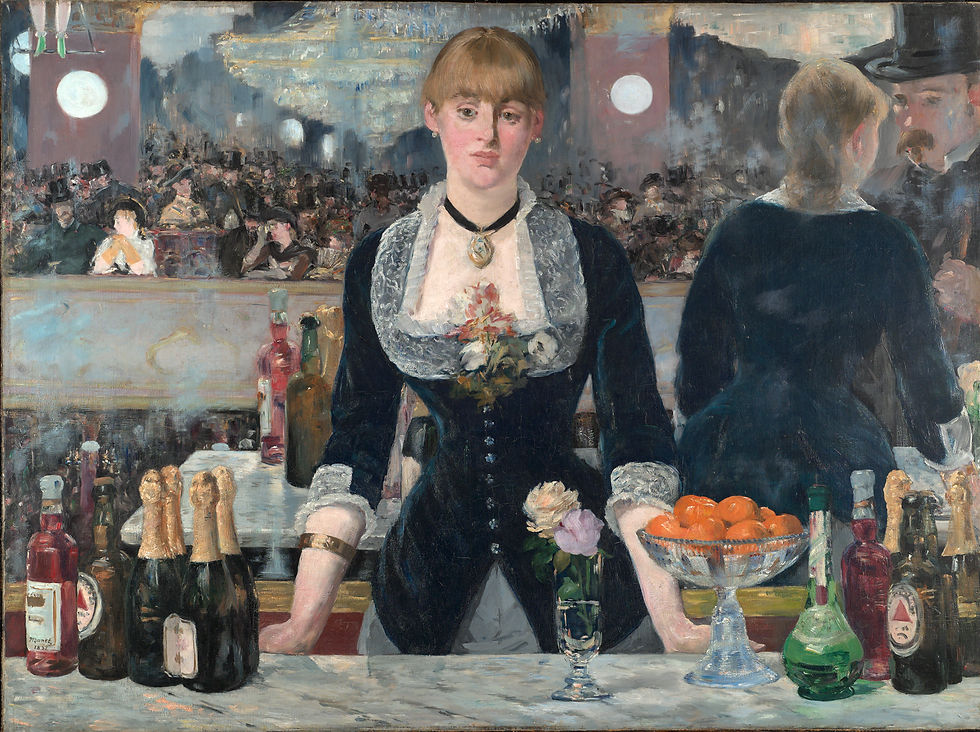Wine and the pleasure of friendship

AT THE TABLE OF MONSIEUR ET MADAME NATANSON
(DÎNER CHEZ MONSIEUR ET MADAME NATANSON)
Henri de Toulouse-Lautrec (1864-1901)
1898
Museum of Fine Arts, Houston, TX, Etats-Unis
In the 19th century good wine, paired with good cheer, became a way of honoring one’s friends. In his ‘Cultural and Social History of Wine’ (published by Larousse), Gilbert Garrier reminds us of the growing popularity of service à la russe at the end of this period. With dinners comprising eight to ten different dishes, served in quick succession, matching wine to different types of food became normal practice, upsetting culinary traditions. Foie gras, previously served after roasted meat, became a starter to be enjoyed with a strong, sweet wine. This would be followed by fish and seafood, a type of dish better matched with light, dry and aromatic white wines such as Chablis or Meursault, served jeunes (young).
Henri de Toulouse-Lautrec illustrates such a scene in this representation of his friends the Natansons, at whose home he often dined. They are shown here at the dinner table, in front of a dish of oysters and several glasses of white wine. The jeunesse (young age) of the wine allowed for the use of a carafe. Red wines would not appear until the second half of the meal, alongside meats, poultry and game. Today, with the help of modern diktats on temperance, an increasing number of people believe that only one type of wine is needed for a dinner party.
Toulouse-Lautrec, a post-Impressionist, shared with the Nabis a colored-tint aesthetic. The audacity of his color mixes heralded the birth of Art Nouveau and Fauvism; Expressionism also made its mark in the violent expressiveness of his work, borne of the artist’s personal dramas (he had been deformed by illness). The freedom of subject, tone and line in his work connect Toulouse-Lautrec to modern art. An independent artist, he distanced himself from the styles of the period. His acuity and sense of psychology allowed him to capture his models on the spot, unposed, regardless of their social position. The artist concentrates on the expressive force of the image, captured with quick and incisive strokes. (Source: Patricia Fride-Cassarat).
In 1889, along with some of his brothers, Thadée Natanson became co-founder and Director of the Revue Blanche. For fourteen years the revue was the mouthpiece of the cultural and artistic intelligentsia of the time. Natanson married Misia Godebska, a flamboyant and highly cultured woman (they were to divorce a few years later). The ‘Queen of Paris’ modelled for Renoir, Toulouse-Lautrec, Vuillard and Bonnard. The Natansons would regularly invite their artist and writer friends to dinner. Thadée Natanson was the author of a book on Toulouse-Lautrec. Here, the artist creates in a few strokes a work which is daring in its use of bright tones and colorful shading.

FANTASY INTERIOR WITH JAN STEEN AND THE FAMILY OF GERRIT SHOUTEN Jan Steen, 1659/60 - The Nelson-Atkins Museum of Art, Kansas City, USA

Mr OLDHAM AND HIS GUESTS Anonymous, ca. 1735/45 - Tate, London

AFTER DINNER AT ORNANS (APRÈS-DÎNER À ORNANS) Gustave Courbet, 1849 - Fine Arts Museum, Lille, France / 3

LUNCHEON ON THE GRASS (DÉJEUNER SUR L'HERBE) Edouard Manet, 1862/63 - Musée d'Orsay Paris / 4
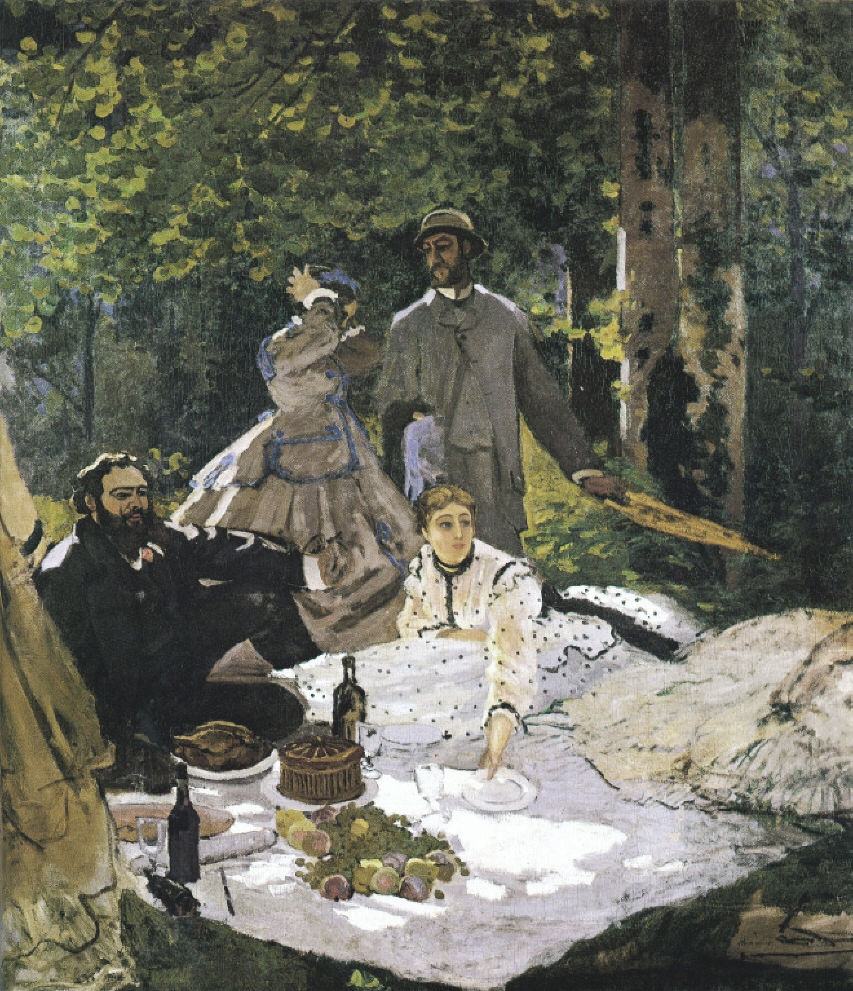
LUNCHEON ON THE GRASS (DÉJEUNER SUR L'HERBE) Claude Monet, 1865/66 - Musée d'Orsay, Paris / 5

BY THE TABLE (COIN DE TABLE) Henri Fantin-Latour, 1872 - Orsay Museum, Paris

AFTER THE LUNCHEON (APRES LE DEJEUNER) Auguste Renoir, 1879 - Städel Museum, Frankfurt, Germany

LUNCHEON OF THE BOATING PARTY (LE DÉJEUNER DES CANOTIERS) Auguste Renoir, 1881 - Collection Phillips Memorial, Washington / 8

IN THE GARDEN. UNDER THE TREES OF MOULIN DE LA GALETTE Auguste Renoir, 1876 - Pushkin Museum, Moscow
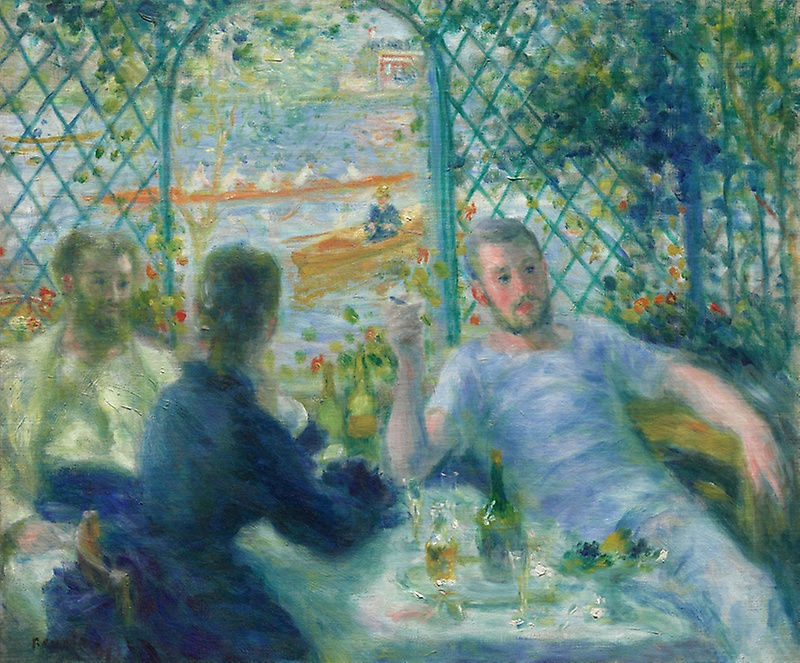
LUNCH AT THE RESTAURANT FOURNAISE (THE ROWERS' LUNCH) Auguste Renoir, 1875 - Art Institute of Chicago, United States

ARTISTS AT BREAKFAST Peder Severin Krøyer, 1883 - Musée de Skagen Museum, Denmark

HIPP HIPP HURRA ! Peder Severin Krøyer, 1888 - Fine Arts Museum, Göteborg, Sweden

IN A ROMAN OSTERIA Carl Bloch, 1866 - Statens Museum for Kunst (SMK), Copenhaguen, Denmark

ON THE BANKS OF THE SEINE Carlo Pittara, 1884 - Private collection

CHESS PLAYERS Thomas Eakins, 1876 - Metropolitan Museum of Art, New York / 15

UNDER THE LAMP (SOUS LA LAMPE) Marie Bracquemond, 1877 - Private collection / 16
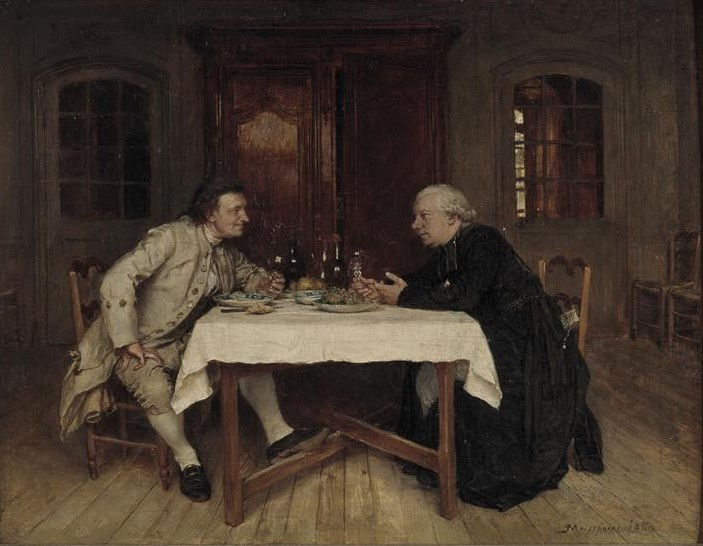
THE PRIEST'S WINE (LE VIN DU CURÉ) Jean-Louis-Ernest Meissonier, 1860 - Fine Arts Museum, Reims, France / 17

AT TABLE Edouard Vuillard, 1893 - The Metropolitan Museum of Art, New York
> Click on the icons for a closer look at the artworks
In the countryside of the 19th century and up until the 1950s, wine was most often drunk among men. In town, this was sometimes also the case. If, since Antiquity, wine was only drunk ‘in society’, wine also became linked to friendship. Although largely present, this theme had been neglected by painters. It was in the 19th century that this was finally illustrated, developed principally by Impressionist and pre- and post-Impressionist painters such as Manet, Monet, Renoir and Toulouse-Lautrec.
3. Courbet describes the scene of After Dinner at Ornans (L’après-dînée à Ornans): “It was the month of November, we were at the house of our friend Cuenot, Marlet had come back from hunting and we had engaged Promayet to play the violin for my father”. The painting is bathed in the weak light of an autumn afternoon, the dînée of the title being an afternoon, rather than an evening, meal. The light plays on the faces, tablecloth and back of the central seated figure, leaving the rest of the scene in shadow; one can hardly make out the imposing fireplace in the background. The colours are few and rather dark – blacks, browns and greys. The pale tablecloth and beige clothing of the hunter stand out all the more. The characters’ warm clothes and the presence of the hunting dog help us to identify this as a scene of autumn. Courbet realistically portrays the leftovers on the table and even a large wine stain on the cloth! He does not try to romanticise the scene, but represents it ‘as is’. His composition is built to convey depth and gives a perfect illusion of space. All these elements work together to evoke a real and recognisable scene. With After Dinner at Ornans, Courbet had a great success in the Salon of 1849, obtaining a gold medal! Delacroix did not hold back with his praise: “Have you ever seen the like, something as strong as this [...]? Here is an innovator, a revolutionary too; he has emerged all of a sudden and without precedent.” The State bought the painting and sent it to the Palais des Beaux-Arts in Lille. As for the small town of Ornans, it gave its son a hero’s welcome!” (Source: Françoise Besson, Panorama de l’art).
4. Le The 19th century saw the arrival of the English picnic in France. Thanks to the railway, the middle classes could lunch on the grass beside the Seine at Argenteuil. This country pleasure is used as a pretext for a well-known painting, Manet’s Luncheon on the Grass. For the first time in the history of the official Paris Salon, 1863 saw artists whose work had been refused being allowed to exhibit them in a small room, annex to the main exhibition, allowing visitors to discover them – the famous Salon des Refusés. By exhibiting three controversial works here Edouard Manet became a figure of the avant-garde. Of his paintings, the central composition of Luncheon on the Grass provoked the strongest reactions. In this work, Manet confirms his break with conventional Classicism. The polemic against him came less from the painting’s style than its subject: although the female nude was already widespread and appreciated (as long as the figure was represented modestly), the shock came from her representation alongside two fully-clothed men. Such a composition rules out the possibility of a mythological interpretation, meaning that the scene has strong sexual connotations. However, the Luncheon on the Grass was actually inspired by a work by Raphael representing two nymphs, and Titian’s Pastoral Concert. The only difference between these paintings and Manet’s scene is in the clothing of the two men. In this way, Manet brings into perspective – and mocks – the tastes and taboos of his era. The wine – an empty bottle among the picnic leftovers – is a mere detail of the composition. But have we ever seen a picnic à la française without wine?
5. In his 1865-1866 response to Luncheon on the Grass, Claude Monet presents a friendly, middle-class leisure scene, featuring Camille Monet and the painters Gustave Courbet and Frédéric Bazille. They are shown eating and drinking on a picnic rug strewn with bottles. However, since the image is a demonstration of the Impressionist style, more emphasis is put on the effect of the light than on the subjects themselves.
8. In 1881, Auguste Renoir immortalised the river-view restaurant of Auguste Fournaise in Luncheon of the Boating Party (Déjeuner des canotiers). The collector Duncan Phillips said that this work “overflows with contagious good humour”. It oozes joie de vivre. The wine in this scene takes centre stage; placed in the centre of the table, it plays an essential role. It contributes to the creation of a happy and serene atmosphere among friends. The wine itself is probably local, from a local hillside. The following quotation, from Maupassant, speaks volumes about the poor reputation of Argenteuil wine at the time: “he compared himself to a man who would sample glass after glass of wine and then be unable to tell a chateau Margaux from an Argenteuil.” Manufactured with little care, strongly sweetened and produced from grapes of wildly varying qualities, Argenteuil wine was considered poor but cheap.
15. Meetings between friends could be more intimate, but even private encounters were subject to certain social niceties. These can be seen in the objects adorning the Victorian living room of the painter’s family in Philadelphia. Port, served in a carafe, was a fashionable late-afternoon drink (we can tell the time of day from the light) for these Chess Players. Thomas Eakins was a Realist painter who studied in France and is greatly appreciated in the USA.
16. Marie and Félix Bracquemond were friends of Manet and Degas, as well as Alfred and Eugénie Sisley, their neighbours at Sèvres, who have come to their home for dinner.
17. Some years earlier, in 1860, Jean-Louis-Ernest Meissonnier portrayed the modest home of a rural priest in The Priest's Wine (Le Vin du Curé). The white tablecloth covers a folding table, on which we can see the leftovers of a frugal lunch where wine was probably the main attraction. The wine is probably the same as that described in the above Renoir painting: a red wine from the banks of the Seine, produced by one of those vineyards “more smoke than grapes” near Poissy, where Meissonnier lived. But at the end of lunch, with fruit, the wine seems better. Glass in hand, the priest describes it his guest in great detail; the latter does not answer, but smiles and listens politely, his right arm resting on the table and hand on leg. Once again, wine allows for relaxation. “After an hour, during a gay tête-à-tête, glass in hand as well as eight prélats, [they] thanked God for a hearty meal.” (Illustration for Les contes rémois, 3rd edition, 1858: Le Bon docteur) The priest’s white wine was reserved for the Mass and donated by parishioners. The wine in this case is a wine of quality, from Chanteloup-les-Vignes – also close to Poissy – and one of those wines which, according to a well-known author, could be compared to the “best tisanes of Champagne”. In layman’s terms, this means that it was a very light wine (Dion). Although the Catholic Church has chosen white wine, this is not the case in the Orthodox and Anglican Church, where red wine is traditional. In Protestant communities, all wines are acceptable, including aperitif wines. In England, a rich church in central London is said to use champagne for its Christmas Eve mass. In Belgravia, perhaps?

INSIDE INN, TWO OLD MEN, A SLEEPER (ALL FRIENDS) Marius Borgeaud, 1916 - Kunst Museum, Winterthur, Switzerland

MY FATHER AND PIACSEK, WITH RED WINE József Rippl-Rónai, 1907 - Hungarian National Gallery, Budapest, Hungary
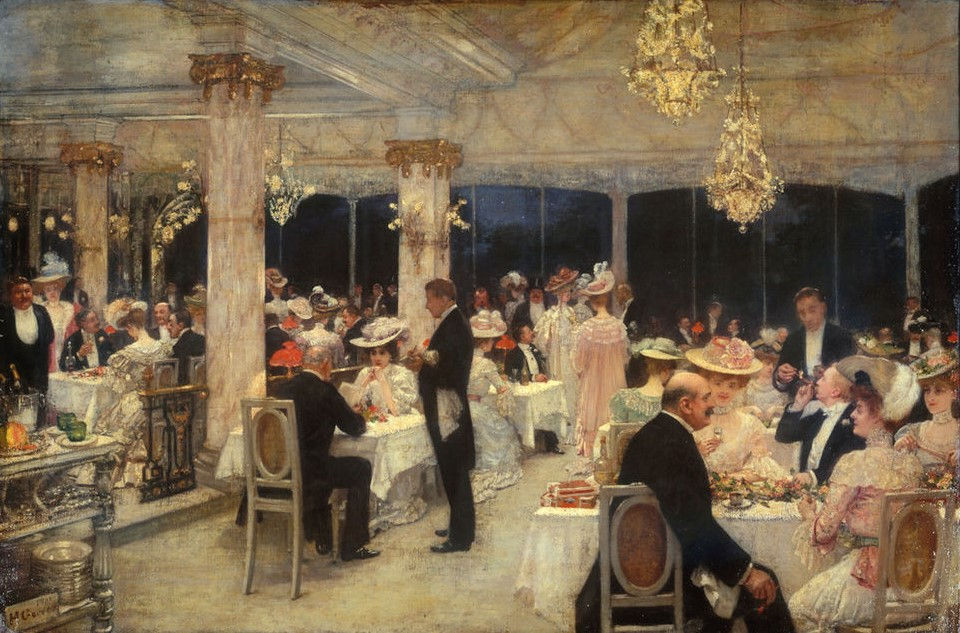
GRAND PRIX EVENING AT ARMENONVILLE (ARMENONVILLE, LE SOIR DU GRAND PRIX) Henri Gervex, 1905 - Musée Carnavalet, Paris / 3
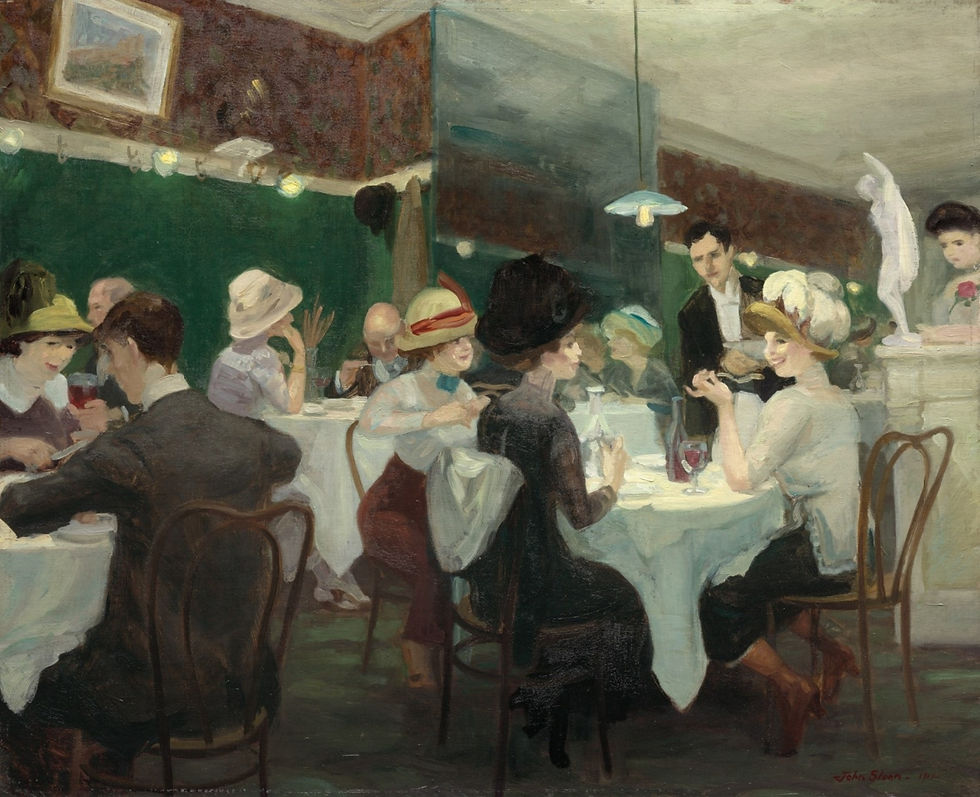
RENGANESCHI'S SATURDAY NIGHT (NYC) John Sloan, 1912 - Art Institute of Chicago (AIC), Chicago

NANA (SEATED LEFT) AND SATIN AT LAURE'S RESTAURANT (Illustration for Emile Zola's Nana) Charles Demuth, 1916 - Moma, New York

THE PURPLE PUP [Cafe à Washington Square, NYC] Charles Demuth, c. 1918 - MFA, Houston, TX, Etats-Unis
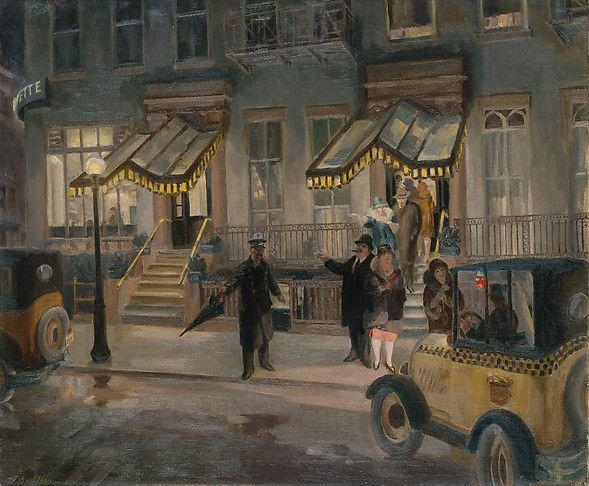
THE LAFAYETTE John Sloane, 1927 - Metropolitan Museum of Art, New York / 7

BASQUES PLAYING CARDS Ramiro Arrue, ca. 1919 - Fine Arts Museum, Bilbao, Spain

EVENING OVER POSTDAM Lotte Laserstein, 1930 - Staatliche Museen, Berlin, Germany

AFTER LUNCH AT FIESOLE Baccio Maria Bacci, 1926/29 - Uffizzy Galleries, Florence, Italy

AT PRUNIER, PARIS (GOBBLERS) Max Beckmann, 1944 - Tate Modern, London

LUNCHEON ON THE GRASS, After Manet Pablo Picasso, 1960
> Click on the icons for a closer look at the artworks
3. The Longchamp Grand-Prix was a high point of the summer social season and the closing supper at the Armenonville Pavillion (in the Bois de Boulogne, Paris) brought together many people, celebrities and friends.
7. Friends can also meet to share food and fine wines in a restaurant. Thus the excitement of ‘going out’ adds itself to the pleasures of eating and being together. John Sloane did this regularly with ‘bohemian’ writer and artist friends, who lived in the Greenwich Village. They enjoyed spending time at the ‘Lafayette’, known for two famous starters but also for its excellent food and wine. The restaurant was demolished in 1953 to make room for a hotel of the same name. Incidentally, New York taxis were already yellow at this time! Sloane’s style brings Dufy to mind. If restaurant businesses have existed in all walks of life throughout history, the first ‘modern’ restaurant (that of the famous chef François-Auguste de Pontac, son of Arnaud III de Pontac, world-renowned artisan of Haut-Brion) only appeared in England in 1666. France’s first restaurant did not open its doors until a century later, despite the country’s solid international reputation for gastronomy. The opening in 1765 of a restaurant near the Louvre, where a certain ‘Boulanger’ served meat consommés and other sophisticated dishes usually reserved for private tables, opened the way for a new profession to challenge the monopoly of private caterers.
10. After the rise of Cubism and Expressionism, realist and genre painters came back into fashion during the “return to normal” of the inter-war period. If 20th-century painters had shown little interest in wine as a social lubricant, these movements touched once more on the world of wine. In Italy, these older movements competed with Futurism. Baccio Maria Bacci, a figurative painter, shows us the end of a lunch in Fiesole, an ancient Tuscan town near Florence. The scene appears to take place during a heatwave, so the characters do not rush. A dreamy, nonchalant atmosphere dominates. One of the guests plucks a few notes on his guitar; we can tell that he is a guest from the table-setting and the dog sitting at his master’s feet. Among the remnants of the meal is a carafe of rosé, probably a type of Vin Santo, a sweet dessert wine traditional in Tuscany, which is supposed to promote meditative thought. Doubtless homemade, the wine is Occhio di pernice (pheasant’s eye), accompanied by almond ricciarelli. Even better shared with friends!
GALLERIES SOCIAL LIFE AND LIFE IN SOCIETY
> Wine and Painting > From Drinking to Savoir-boire > Social Life and Life in Society > With Friends



